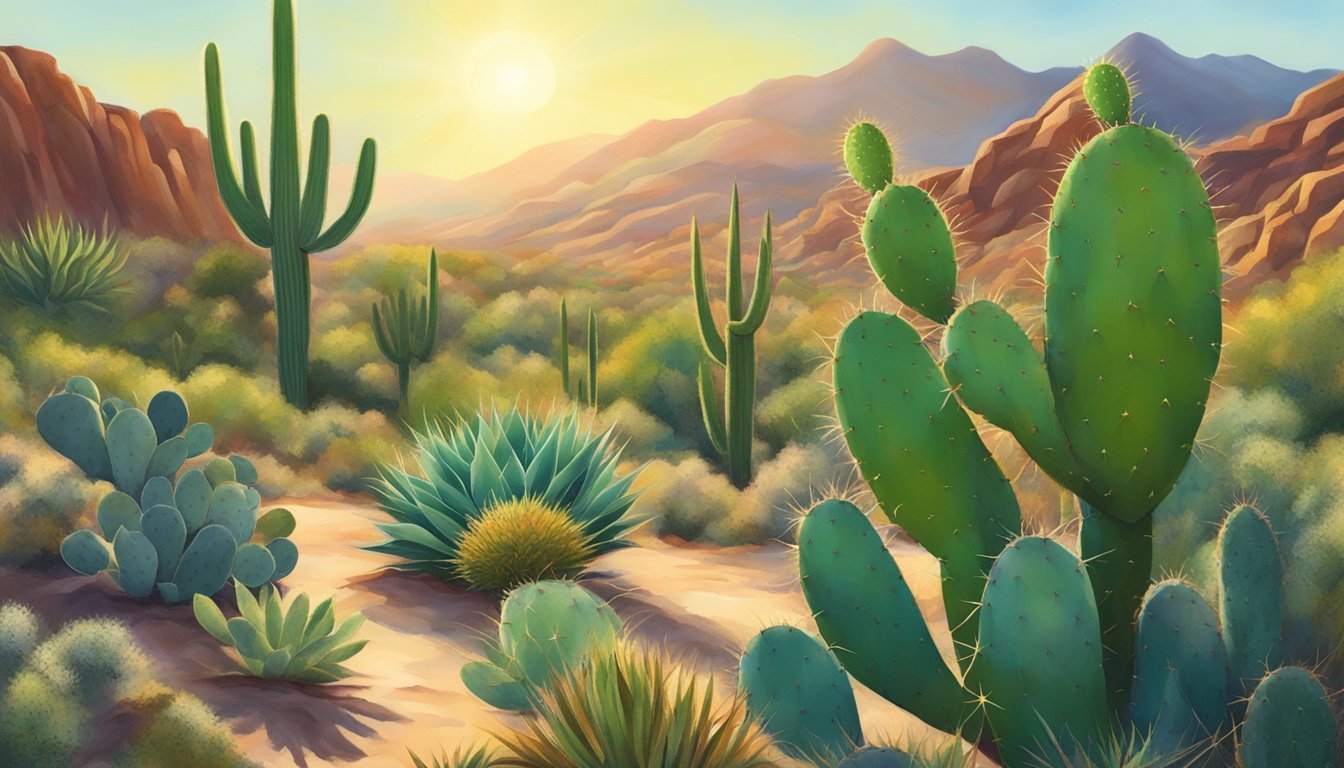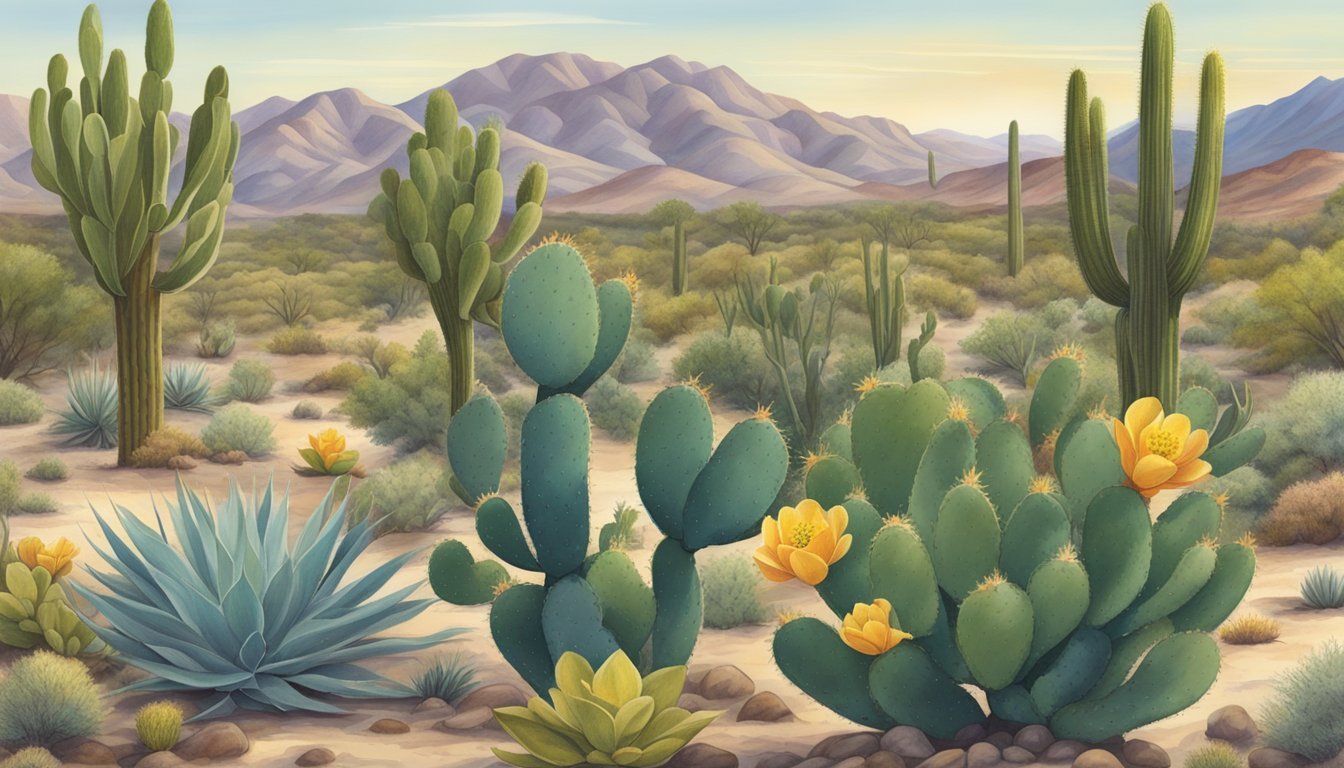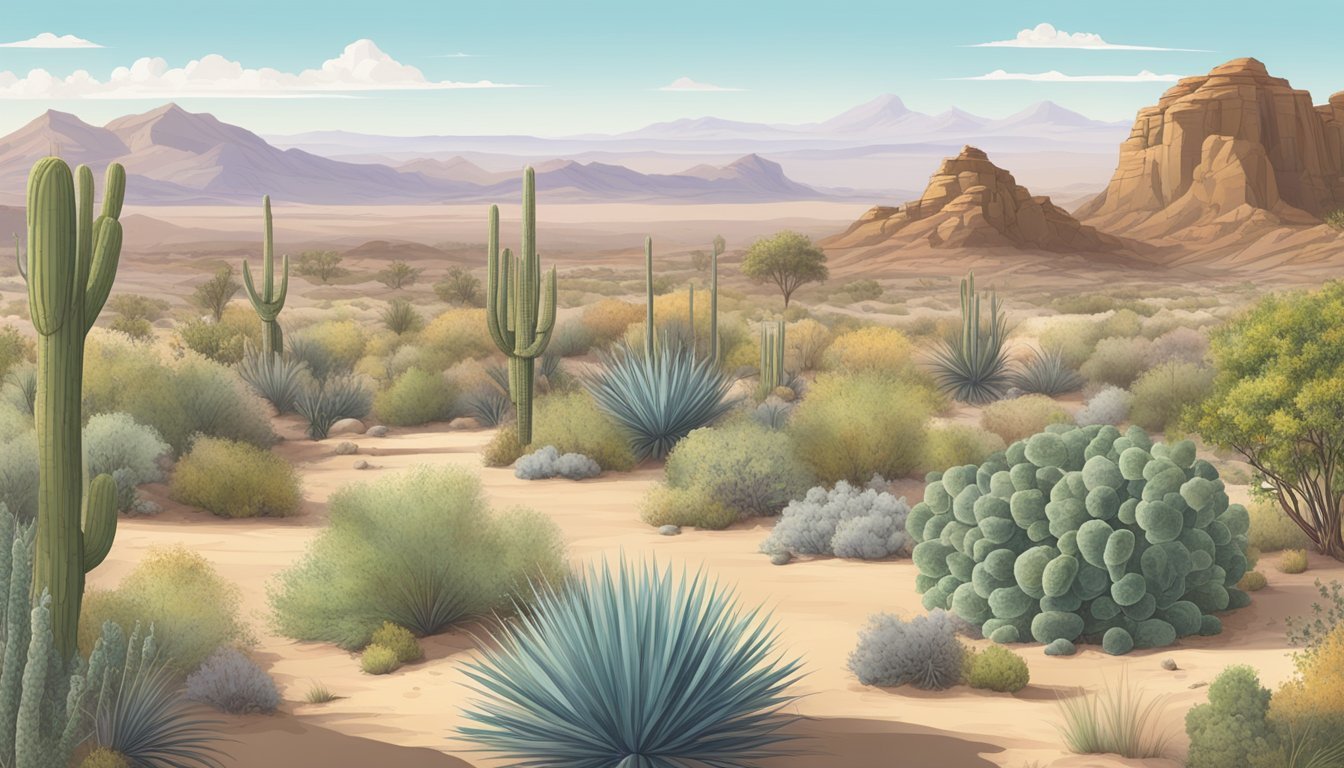Native Edible Plants in Arizona
A Guide to Foraging in the Desert
This Article is Part of Foraging Guide for All 50 US States
Arizona's vast and varied landscape hosts an array of native edible plants, many of which are resilient species adapted to the arid conditions of regions such as the Sonoran Desert. For centuries, these plants have served as food sources for indigenous peoples, and today, they continue to offer foraging opportunities for those interested in sustainable and local foods. The knowledge of such plants is not only valuable for their nutritional contributions but also for the cultural history they embody.
Understanding which desert plants are safe to eat is vital for anyone looking to explore Arizona's natural pantry. Among the diverse flora, certain cacti, beans, herbs, and greens stand out for their edibility and nutritional content. Examples include the fruit of the prickly pear cactus, the pods of the mesquite tree, and the leaves of the dandelion, which are all found throughout the state.
As one learns about the native edible plants of Arizona, it becomes clear that the desert's seeming barrenness belies a rich tapestry of food sources. These plants not only survive but thrive under harsh conditions, offering sustenance that is as hearty and robust as the landscape itself. Recognizing and appreciating these wild edibles encourages a deeper connection to the environment and an understanding of the state’s natural resources.
Interested in Mushroom Hunting in Arizona?
Arizona's diverse landscapes, from the high-elevation forests to the desert canyons, offer unique opportunities for mushroom hunting. The state is home to edible species like morels, chanterelles, and oyster mushrooms. With proper identification skills and respect for public and private land regulations, foraging in Arizona promises an exciting and rewarding experience.
👉 Guide on Mushroom Hunting in Arizona
Understanding Arizona's Native Flora
Arizona's native flora is rich in diversity and plays a critical role in the ecological balance of the region. These plants not only offer sustenance but also hold significant ecological value in the Desert Southwest.
The Diversity of the Sonoran Desert
The Sonoran Desert is home to a wide array of plant species uniquely adapted to its hot, arid environment. Cacti, such as the iconic saguaro (Carnegiea gigantea), and shrubs like the desert lavender (Hyptis emoryi) thrive in this landscape. Various trees, including the desert ironwood (Olneya tesota), offer shelter and food for wildlife, showcasing the desert's plant diversity.
Importance of Native Edible Plants
Edible plants native to Arizona are not just food sources for humans; they also provide essential nutrients to the local fauna. The fruit of the prickly pear cactus (Opuntia spp.) is a staple, consumed by both animals and people, and is high in vitamins and minerals. Mesquite trees (Prosopis spp.) produce pods that are milled into nutrient-rich flour (how long does flour last?), demonstrating the utility and importance of these native plants.
Ecological Significance of Edible Flora
The edible flora of Arizona contributes significantly to the region's ecological stability. These plant species support pollinators like bees and hummingbirds, and their seed dispersal is often facilitated by the animals that feed on them. The roots and foliage help prevent soil erosion, retaining water and contributing to the health of the entire ecosystem.
Foraging Basics and Safety
Foraging for edible plants in Arizona requires knowledge of plant identification and adherence to safe and ethical practices. This section provides practical guidance for anyone interested in responsible foraging.
Identifying Edible Plants
Accurate identification of edible plants is the cornerstone of foraging. One misidentification could lead to dangerous consequences. Foragers should:
Use field guides with clear photographs and descriptions.
Attend workshops given by local experts.
Cross-reference multiple sources before consuming any wild plant.
Foraging Ethics and Practices
Ethical foraging ensures the sustainability of natural resources for future generations. Foragers are encouraged to:
Obtain permission from landowners or regulators before foraging on private or protected lands.
Harvest only what is needed, typically no more than one-third of an existing plant population.
Avoid rare, threatened, or endangered species by familiarizing oneself with local regulations.
Cautionary Tips for Safe Consumption
Safety is paramount when consuming foraged plants. Foragers should keep the following in mind:
Never consume a plant unless 100% certain of its identification and edibility.
Introduce new plants gradually into the diet to monitor for possible allergic reactions.
Wash all foraged items thoroughly to remove potential contaminants.
Be aware of environmental hazards, such as polluted soils or pesticide exposure, that could affect plant safety.
Popular Native Edible Plants
Arizona's food landscape is rich with a variety of native plants that have fed its inhabitants for centuries. These plants are not only integral to the local ecosystem but are also a source of nourishment for those who understand their uses.
Prickly Pear (Opuntia)
The Prickly Pear cactus is recognized for its flat, fleshy pads called nopales, and its colorful fruits, often known as tunas. The pads are a staple in many dishes after being carefully cleaned of spines, and the fruit can be consumed raw or made into jellies and beverages.
Mesquite Trees (Prosopis)
Mesquite trees provide pods that have long been ground into flour by indigenous peoples. High in protein and fiber, this flour has a sweet, slightly nutty taste, and is used to make mesquite meal, which can be baked into breads and other goods.
Palo Verde (Parkinsonia)
The Palo Verde is notable not only for its green bark but also for the edible seeds (how long do seeds last?) it bears. They can be picked when they're young and tender and cooked as a vegetable. When mature, the seeds harden and can be roasted and ground into flour.
Cholla (Cylindropuntia)
Cholla buds are harvested in the spring, often meticulously de-spined, and then boiled or steamed. They offer a source of vitamins and minerals and are sometimes pickled for long-term storage or immediate consumption as a tangy treat.
Nutritional Benefits and Culinary Uses
Exploring the native edible plants of Arizona offers insights into their rich nutrient profiles and diverse culinary applications. These plants provide essential proteins and vitamins, and they have been incorporated into both traditional and contemporary recipes.
Proteins and Vitamins in Desert Plants
The native flora of Arizona is a surprisingly good source of proteins and vitamins. For example, Mesquite pods are not only high in protein but also contain calcium, magnesium, potassium, iron, zinc, and lysine. The Cholla cactus provides buds packed with protein and vitamin C, while prickly pear pads, known as nopales, offer both fiber and vitamin C.
Notable Nutrient Sources:
Mesquite Pods: Protein, Calcium, Potassium
Cholla Buds: Protein, Vitamin C
Nopales: Fiber, Vitamin C
Preparing and Cooking Native Plants
The safe preparation and cooking of Arizona's edible plants are crucial to their nutritional retention and enhancement of flavor. Nopales, for instance, are often de-spined and grilled to create a smoky flavor, while mesquite flour made from ground pods can be used in baking. The seeds of the saguaro cactus fruit can be toasted and used as a nutty topping for various dishes.
Key Cooking Methods:
Nopales: Grilling, Boiling
Mesquite Flour: Baking, as a Thickener
Saguaro Seeds: Toasting
Traditional and Modern Recipes
Traditional recipes have honored these plants for centuries, while modern chefs are finding innovative uses for them. Mesquite flour is used in breads and pancakes, adding a sweet, nutty flavor. Prickly pear fruit is turned into syrups and jellies, frequently used to glaze meats. The Tohono O'odham people have long made a sweet, fermented beverage known as Tiswin from saguaro fruit.
Recipes Featuring Native Plants:
Mesquite: Mesquite Bread, Mesquite Pancakes
Prickly Pear: Syrups, Jellies, Glazes
Saguaro: Tiswin (Fermented Beverage)
Harvesting Techniques and Preservation
When harvesting native edible plants in Arizona, it’s critical to employ sustainable techniques and proper methods of preservation to ensure plant populations remain healthy and available for future use.
Best Practices for Harvesting
Harvesting should always be carried out during the appropriate season to ensure plant health and optimal nutrient content. For instance, seeds are best collected in the late summer or fall when they are ripe but before they are dispersed. It is important to use clean, sharp tools to avoid damaging the plant or its habitat. Harvesters should:
Identify plants correctly to avoid picking endangered or toxic species.
Take only what is needed, usually less than a third of a plant population, to prevent overharvesting.
Collect seeds by shaking pods directly into a bag or by cutting the seed heads.
Storing and Preserving Harvested Plants
After harvesting, proper preservation techniques are necessary to maintain the edibility and nutritional value of the plants:
Drying: Many plants and seeds can be dried. Spread them out in a single layer in a dry, well-ventilated space out of direct sunlight.
Canning: Certain plants can be preserved through canning. Use a pressure canner for low-acid foods to prevent spoilage.
Freezing: Freezing is suitable for many harvested plants. Blanch them before freezing to preserve color, flavor, and texture.
Note: Always label preserved goods with the date of harvest and the preservation method used.
Contribution to Local Culture and Economy
Edible plants native to Arizona have played a significant role in shaping the cultural identity and economic landscape of the region. They continue to influence local traditions and contribute to the state’s economy.
Native Americans and Edible Plants
Native American communities in Arizona have historically relied on an array of indigenous plants for nourishment, medicine, and ceremonial purposes. The Tohono O'odham people, for example, harvest the fruit of the saguaro cactus to make syrups, jellies, and wine, which are integral to their cultural customs and annual celebrations. The gathering and preparation of these plant foods reinforce cultural practices and the transmission of traditional ecological knowledge.
Saguaro cactus fruit: Jams, syrups, traditional wine
Mesquite trees: Flour from pods, seasonings
Cholla buds: Protein-rich food source, traditional dishes
Prickly pear cactus: Fruit and pads for food, juice, and candies
Edible Plants in Arizona's Economy
The commercial use of Arizona's native edible plants has ripened into a niche market that supports local economies and promotes sustainable agriculture. Businesses capitalize on the unique flavors of these plants, incorporating them into products such as mesquite-smoked meats (What wine goes well with smoked meats?), prickly pear candies, and teas made from native herbs. These products not only cater to the increasing consumer interest in local and indigenous foods but also stimulate agricultural tourism and create jobs centered around foraging and processing these traditional resources.
Market products:
Mesquite flour and smoked meats
Prickly pear beverages and confections
Herbal teas from native plants
Economic impacts:
Agricultural tourism: Tours, festivals, foraging workshops
Job creation: Harvesting, processing, marketing of native plant products
Trade: Sale and exchange of native seeds and plant material within and beyond Arizona
Conservation and Ethical Considerations
In the context of Arizona's native edible plants, conservation efforts and ethical considerations are necessary to maintain the state’s botanical heritage and biodiversity. Sustainable practices are essential to counteract the impact of overharvesting.
Impact of Overharvesting
Overharvesting of native edible plants can lead to species decline and habitat disruption. For example, the Chiltepin pepper (Capsicum annuum var. glabriusculum), highly prized for its culinary use, has seen populations dwindle due to unregulated harvesting. Similarly, the Toothache plant (Acmella oleracea), used for its medicinal properties, is at risk when harvest exceeds the plant’s ability to replenish naturally.
Key Species at Risk:
Capsicum annuum var. glabriusculum (Chiltepin pepper)
Acmella oleracea (Toothache plant)
Excessive harvesting practices threaten not just individual species but also the ecosystems that depend on them. These plants are often integral to soil health and local wildlife dietary needs. With their roles in pollination and seed dispersal, sustaining their populations is critical.
Sustainable Use and Conservation Efforts
Conservation agencies and local communities advocate for sustainable harvesting methods to protect native plant species. Initiatives include:
Cultivation Projects: Encouraging the growth of native plants in personal and community gardens to alleviate wild harvesting pressures.
Example: Native Seed/SEARCH is an organization promoting the sustainable cultivation of regional plants.
Educational Outreach: Informing the public about the importance of these plants and how to ethically harvest them.
Example: Workshops on sustainable foraging techniques.
Conservation Strategy Description Permits and Regulations Implementation of harvesting permits and guidelines drives ethical foraging behaviors. Habitat Restoration Active restoration of native plant habitats to combat the consequences of overharvesting.
By integrating ethical considerations into conservation efforts, such as respecting indigenous traditions and knowledge, Arizona can maintain its rich diversity of native edible plants. It involves a commitment from individuals, communities, and organizations to practice restraint and care in the use of natural resources.
Identifying and Managing Risks
When foraging for native edible plants in Arizona, it is crucial to recognize and manage certain risks to ensure safety. These risks include the presence of toxic lookalikes, natural plant defenses, and the potential for plant-induced ailments.
Toxic Lookalikes and Plant Defenses
It's imperative to distinguish edible plants from their toxic counterparts. Many edible plants have lookalikes that contain poisons, which can cause serious harm if ingested. For instance, the edible Miner's Lettuce (Claytonia perfoliata) can be confused with the toxic Lily of the Valley (Convallaria majalis), which is not native to Arizona but might be found in landscaped areas. It’s essential to examine distinctive features carefully:
Edible Plant Toxic Lookalike Distinctive Feature to Identify Miner's Lettuce Lily of the Valley Flowers emerge from within the leaf.
Additionally, certain native plants have thorns and spines as part of their defenses, such as the Prickly Pear Cactus (Opuntia spp.), which requires careful handling to avoid injury.
First Aid for Plant-Induced Ailments
In the event that someone consumes part of a toxic plant or has a negative reaction to a plant's defenses, having knowledge of first aid is vital:
Identify the Plant: Secure a sample of the plant for identification, which can assist medical professionals.
Seek Immediate Help: Contact poison control and seek medical attention immediately if serious symptoms arise.
Skin Irritation: For skin irritation from thorns or spines, carefully remove any embedded parts with tweezers and clean the area thoroughly to prevent infection.
Understanding the risks and knowing how to manage them is key when foraging for edible plants in Arizona. Always be cautious and prepared for potential hazards.
Educational Resources and Further Learning
For individuals eager to expand their knowledge about Arizona's native edible plants, a variety of educational resources and avenues for further learning are available. These include published materials, personal experiences through guided tours, and digital courses.
Books and Field Guides
A comprehensive understanding often begins with foundational literature. Books and field guides provide detailed information and are essential tools for both beginners and experts. Highlights include "Edible and Medicinal Plants of the Southwest" by John Slattery and "A Field Guide to the Plants of Arizona" by Anne Orth Epple. These guides typically come in portable formats with clear illustrations, making them practical for field use.
Recommended Books:
"Edible and Medicinal Plants of the Southwest" by John Slattery
"A Field Guide to the Plants of Arizona" by Anne Orth Epple
Workshops and Guided Tours
Hands-on learning can enhance the educational experience. Workshops and guided tours provide immersive opportunities to identify plants in their natural habitats. They are conducted by knowledgeable individuals who offer insights into plant uses and ecological importance. Arizona’s natural history museums and local botanical gardens often host workshops and tours for this purpose.
Guided Tours Providers:
Desert Botanical Garden in Phoenix
Boyce Thompson Arboretum in Superior
Online Courses and Websites
The digital sphere offers online courses and websites as a convenient platform for education. Learners can access structured courses and a plethora of resources, such as informative PDFs from university extension programs. Arizona Native Plant Society and other educational websites provide lists of online courses, webinars, and comprehensive information.
Online Learning Resources:
Arizona Native Plant Society website
University extension program PDF resources








